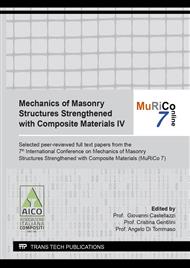p.401
p.409
p.417
p.425
p.433
p.443
p.449
p.457
p.465
Experimental Study on the Tensile and Bond Properties of a FRCM System for Strengthening of Masonry Construction
Abstract:
The use of inorganic matrix in fiber reinforced composites has been studied in the last years for strengthening applications in masonry construction. At the moment different systems are available after a technical qualification that allows a safe and certified use in construction industry. In the field of historical masonry the benefits of such materials are well known respect to the most known Fiber Reinforced Polymers (FRPs), due to a very poor substrate. In this study the experimental results of a larger research program are presented and discussed. A Fiber Reinforced Cementitious Matrix (FRCM) system has been tested in order to measure the tensile mechanical properties and bond properties respect to different substrates: clay masonry and natural tuff masonry. Tensile properties of the FRCM composite were measured in presence of a cement mortar, and results are illustrated. In addition pull-off tests and bond shear lap tests of the FRCM are described and commented respect to the two substrates. Tensile tests on glass fiber mesh and glass FRP (GFRP) connectors were performed and results are presented in the paper.
Info:
Periodical:
Pages:
433-440
Citation:
Online since:
April 2022
Keywords:
Price:
Сopyright:
© 2022 Trans Tech Publications Ltd. All Rights Reserved
Share:
Citation:


